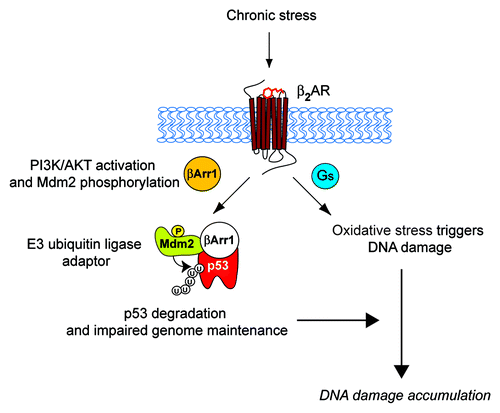Figures & data
Figure 1. Schematic diagram of β2AR-dependent regulation of DNA damage in the catecholamine-mediated stress response. The stress response and activation of the sympathetic nervous system (SNS) release catecholamine stress hormones, such as epinephrine, which activate β2AR and its downstream signaling pathways. This initiates activation of Gs-PKA signaling and cytosolic β-arrestin-1 (βArr1: orange)-mediated activation of PI3K/AKT signaling leading to phosphorylation and activation of Mdm2. βArr1 in the nucleus (white) facilitates the Mdm2-mediated nuclear export and degradation of p53, compromising genome maintenance.Citation22 Meanwhile, stimulation of β2AR leads to production of reactive oxygen species by NAD(P)H oxidase,Citation23 and activation of adenylyl cyclase and PKA signaling promotes oxidative stress by suppressing antioxidative mechanisms.Citation24 Thus, these two independent G-protein and β-arrestin-mediated pathways synergistically affect the accumulation of DNA damage. P, phosphorylation at ser 166 on Mdm2; U, ubiquitination.

Figure 2. Behavioral stress leads to accumulation of DNA damage and reduced levels of p53. (A) Restraint stress leads to accumulation of DNA damage and lowering levels of p53. After restraint stress, wild-type mice (WT) were sacrificed, brains were removed, and brain frontal cortex was dissected. Their homogenates were analyzed by immunoblotting with indicated antibodies. DNA damage was examined by phosphorylation of histone H2AX (γ-H2AX), one of the earliest indicators of DNA damage.Citation63 Mean ± SEM. Student’s t-test, two-tailed. n = 10 for each condition. (B) Genetic deletion of β-arrestin-1 abrogates the DNA damage accumulation and p53 degradation induced by restraint stress. After restraint stress, β-arrestin-1-knockout mice (βArr1−/−) were sacrificed, brains were removed, and brain frontal cortex was dissected. Mean ± SEM. Student’s t-test, two-tailed. n = 5 for each condition. (C) Propranolol, a β-blocker, inhibits the accumulation of DNA damage and p53 degradation induced by restraint stress. Propranolol (Prop) was administered to WT, starting 2 d before the first exposure to restraint stress. Mean ± SEM. Student’s t-test, two-tailed. n = 10 for each condition.
